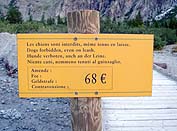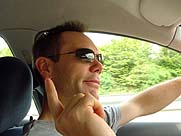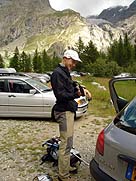|
 |
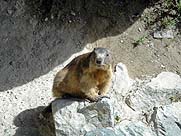 |
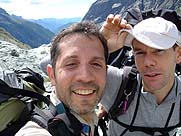 |
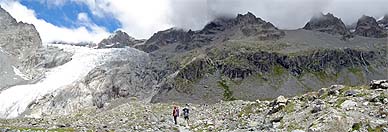 |
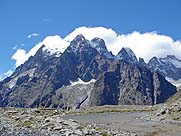 |
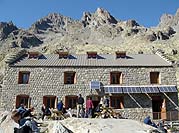 |
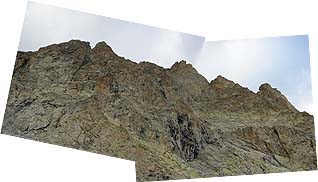 We arrived at the
refuge at
12:30 and after a quick lunch
and some description de la voie
(a.k.a. Beta) from the guardien,
we headed for Les
Pointe des Cinéastes (3205m, a prominent ridge
behind the refuge).*
As we needed to be back at the refuge for
dinner at
18:00, we ran up the scree field. The clouds engulfed the ridge giving
it a extremely alpine character. François took the first lead
and off we were along the Arête
Sud
Classique (a.k.a. Voie Normale,
AD). We devoured the pitches jumping from tower to tower, only slowed
down by the continuous entanglement of the ropes
(
We arrived at the
refuge at
12:30 and after a quick lunch
and some description de la voie
(a.k.a. Beta) from the guardien,
we headed for Les
Pointe des Cinéastes (3205m, a prominent ridge
behind the refuge).*
As we needed to be back at the refuge for
dinner at
18:00, we ran up the scree field. The clouds engulfed the ridge giving
it a extremely alpine character. François took the first lead
and off we were along the Arête
Sud
Classique (a.k.a. Voie Normale,
AD). We devoured the pitches jumping from tower to tower, only slowed
down by the continuous entanglement of the ropes
( to this day I
think that the
rope problem was due to the way in which François coiled the
ropes, as later
on the trip, when I insisted that we use the butterfly coil, the
problem diminished).
to this day I
think that the
rope problem was due to the way in which François coiled the
ropes, as later
on the trip, when I insisted that we use the butterfly coil, the
problem diminished).
We came to a spot that clearly demanded more attention. I took time off for a nature's call after which François accomplished a most amazing lead (about 5c [5.8] on mountain boots). When my turn came, I sure was so glad that it had not been me leading that pitch. In the interest of saving time, we decided to bypass one tower (I am not sure if it was the 3éme or 4éme pointe) and then the final pitch was mine. When I found a beautiful rappel station at the very top of the 6éme pointe, I felt a total sense of accomplishment.
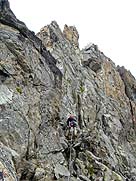 One
of the biggest axioms of alpinism is that you are not done with a climb
until you are back safe on the ground. More often than not, accidents
occur on the descent of the mountain where downward movements can be
awkward
and fatigue is more prevalent. Although the descent
route
is towards the SE, from the col after the 6éme
pointe, we did not know this as we did not have a climbing guidebook
and
instead, we rappelled down the Éperon
Ouest (a.k.a. Face Ouest,
D). I
prepared the
first rappel which went smoothly, but when it came time for the second
rappel, François cursed and
fought with the entangled ropes as
One
of the biggest axioms of alpinism is that you are not done with a climb
until you are back safe on the ground. More often than not, accidents
occur on the descent of the mountain where downward movements can be
awkward
and fatigue is more prevalent. Although the descent
route
is towards the SE, from the col after the 6éme
pointe, we did not know this as we did not have a climbing guidebook
and
instead, we rappelled down the Éperon
Ouest (a.k.a. Face Ouest,
D). I
prepared the
first rappel which went smoothly, but when it came time for the second
rappel, François cursed and
fought with the entangled ropes as 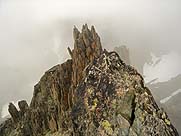 he could not find the next
rappel
station. He
was forced to stop on a small ledge and asked me to come down to see
if I could spot the elusive station, even as he remained on rappel on
the same rope (not a very advisable practice).
he could not find the next
rappel
station. He
was forced to stop on a small ledge and asked me to come down to see
if I could spot the elusive station, even as he remained on rappel on
the same rope (not a very advisable practice).
On my way down, I had no problem spotting the next rappel station and soon I was attached to it. François though was some 20m to my left, parallel to me, at a most awkward spot. I asked him to wait until I placed him on belay and then he took the first step of what was to be a very long and exposed traverse.
 As
he moved towards me his incessant cursing told the story;
this
was a time when he could not fall. A step, more cursing, a
sudden stumble, a big check for equilibrium, and he was gone! When
things
like this happen time appears to slow down, and slowly I could see
François
screaming profanity on his way down the mountain -- I even had time to
think "there goes the vacation". An instant later, I felt the huge tug
of the ropes on the belay station and with it the painful screams of
François somewhere down the mountain. At least the screams
indicated that he was not
dead, but they could mean that he was
very hurt -- maybe
with a broken leg or even worse. As I prepared the ropes to go down to
attend to him I kept on screaming asking for his condition. To my
total amazement, François appeared from behind a rock
like Jesus appeared to the apostles after the resurrection (John 20:19). François
was still shouting profanity and as I pulled on the
ropes
to bring him
safely to the belay station, one rope hit him on the face provoking
an angry "Qu'est-ce
que tu fais?".
This was clearly not the time to tell someone to be "nice", and
even though he later apologized for having screamed at me,
I now realized that we never
recovered from that moment.
As
he moved towards me his incessant cursing told the story;
this
was a time when he could not fall. A step, more cursing, a
sudden stumble, a big check for equilibrium, and he was gone! When
things
like this happen time appears to slow down, and slowly I could see
François
screaming profanity on his way down the mountain -- I even had time to
think "there goes the vacation". An instant later, I felt the huge tug
of the ropes on the belay station and with it the painful screams of
François somewhere down the mountain. At least the screams
indicated that he was not
dead, but they could mean that he was
very hurt -- maybe
with a broken leg or even worse. As I prepared the ropes to go down to
attend to him I kept on screaming asking for his condition. To my
total amazement, François appeared from behind a rock
like Jesus appeared to the apostles after the resurrection (John 20:19). François
was still shouting profanity and as I pulled on the
ropes
to bring him
safely to the belay station, one rope hit him on the face provoking
an angry "Qu'est-ce
que tu fais?".
This was clearly not the time to tell someone to be "nice", and
even though he later apologized for having screamed at me,
I now realized that we never
recovered from that moment.
François had a huge bruise on his ass, but he
was Ok. A number of things had saved his life: the knots at the end of
the ropes prevented him from rappelling off the end of ropes as he
hurled out of control down the mountain; his instinct to run down the
mountain keeping the rope taught at all times prevented him from
tumbling out of control; and his great physical condition kept
his bones intact in spite of the force of the final crash.  But
above all, we were both lucky -- something you should never count on in
the mountains. In hindsight, François should have let go of one
of the ropes, I should have placed him on belay on the other, and as
they were knotted together at the rappel station above François
would have been on a top-rope at all times during the traverse. I guess
this one of those
times that you can really say "live and learn".
But
above all, we were both lucky -- something you should never count on in
the mountains. In hindsight, François should have let go of one
of the ropes, I should have placed him on belay on the other, and as
they were knotted together at the rappel station above François
would have been on a top-rope at all times during the traverse. I guess
this one of those
times that you can really say "live and learn".
After the accident I set
up the rest of the rappels and we were back on the ground, shaken,
late, but safe. We headed back for the refuge as fast as my
ankle would
allow and arrived in time for the last supper of the day.
Guidebooks:
*Jean Michel Cambon, "Oisans Nouveau, Oisans Sauvage: Livre Est : 250 itinéraires d'escalade et d'alpinisme parmi les moins pires massifs des Ecrins-Est, du Briançonnais et des Cerces", 2004, pp.176-177.John Brailsford, "Ecrins, Massif Cerces and Queyras: Selected Climbs", Alpine Club Guide Books, 2002, pp. 136. (also available at Cordee)
 Pedro
I. Espina© 2005
Pedro
I. Espina© 2005
